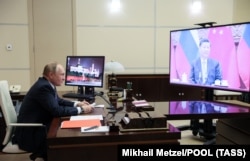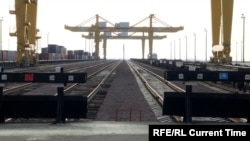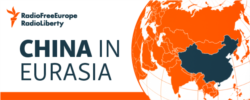
Happy New Year and welcome back to the China In Eurasia briefing, an RFE/RL newsletter tracking China’s resurgent influence from Eastern Europe to Central Asia.
We’ll be doing things a little bit differently this week. This is a special edition of the newsletter that will be taking stock of a very eventful 2021 and looking ahead to some of the biggest stories to watch this year across Eurasia and inside China.
I’m RFE/RL correspondent Reid Standish and here’s what I’m following for 2022.
What To Watch In 2022
From the Beijing Olympics to increased tensions with Taiwan, there’s no shortage of important China stories on the horizon for 2022.
Here’s an overview of the top trends to watch for China’s growing footprint across Eurasia for this year. (Keep scrolling for other China developments to watch in 2022)
Finding Perspective: As 2021 began, Beijing was feeling triumphant from its handling of the COVID-19 pandemic at home and from signing a massive trade deal with the European Union in late December 2020.
But as the year went forward, China saw many of its foreign policy plans derailed. The EU trade pact was put on ice following tit-for-tat sanctions with the bloc over Beijing's abuses of Uyghurs and the country’s image across much of the West has fallen to new lows.
In Eurasia, however, Beijing’s outlook is much more rosy. While relations have soured with many European nations, China is still ascendent across much of the supercontinent.
I surveyed a group of leading experts and analysts and picked five big stories to follow for this year: Beijing continuing to grow its security presence, a new era of relations with the Kremlin, shifting the Belt and Road away from big infrastructure projects, doubling down on Wolf Warrior diplomacy, and rewiring cross-border trade with China’s neighbors.
For a more detailed look, read the article here.
Why It Matters: The prediction business is a messy one, but Beijing finds itself well-placed beyond its western borders and will have no shortage of opportunities to keep progressing on the gains it has made across the region.
The big question is what kind of unforeseen developments does 2022 have in store for Eurasia and how could the fallout affect Beijing?
A prolonged energy crisis and rising costs could provoke political instability in Central Asia. Afghanistan will continue to be a looming security threat on Beijing’s radar, and another Russian invasion of Ukraine could unleash a host of ripple effects that might affect Chinese initiatives across the region and beyond.
Read More
● What’s next for Afghanistan after the United States’ withdrawal? My colleague Ron Synovitz takes a look at what’s at stake for the country as the wider geopolitical map gets redrawn in the region.
● A wall of maturing debt and a surge in seasonal demand for cash will test China’s financial markets in January, Bloomberg reports.
● Washington is preparing for the wrong war with China, Hal Brands and Michael Beckley argue in Foreign Affairs.
Expert Corner: Forecasting Chinese Foreign Policy
Readers asked: “What is the 2022 forecast for Chinese foreign policy?”
“The combination of needing to shore up a defensive front against those calling for a boycott of the Beijing Winter Olympics, together with the successful staging of the actual event -- if the 2008 Beijing Summer Games are anything to go by -- will mean a prouder, more nationalistic China.
“This may translate into an even more retributive foreign policy. Watch what more Beijing will do to Lithuania, especially with an EU distracted by Russian maneuvers. Also look at China-Australia relations. It’s often been a harbinger of how relations will unfold with the United States and Europe. Unfortunately, we’ll continue to see PLA jets enter Taiwan’s Air Defense Identification Zone. Some argue the maneuvers are not really a threat. Regardless of your take, what is true is these moves are exhausting and testing the island’s air force, and contributing to instability in the region as neighboring countries look on nervously.” -- Melissa Chan, former China correspondent and now a Berlin-based contributor to The Global Reporting Centre
"In 2022, Chinese foreign policy will remain aggressive, with more incursions into Taiwan's air defense identification zone, the continued militarization of China's Indian border, and retaliation to perceived slights -- like when China started a trade war with Australia after Canberra called for an investigation into COVID-19's origins. Additionally, Beijing will maintain its outreach and provision of economic assistance to Global South countries, which form the backbone of China's international support.
“Still, aggressiveness will remain constant because of Xi Jinping: There are few constraints on his authority; Chinese foreign policy has accordingly evolved with his ideology, becoming more impulsive and combative. Augmenting this is the fact that his domestic legitimacy hinges at least somewhat on nationalism, which China has stoked with decades of 'patriotic education.' For Xi, then, foreign policy aggressiveness is not only a personal preference, but a way to solidify his grip on power at home.” -- Charles Dunst, fellow at the Center for Strategic and International Studies
Do you have a question about China’s growing footprint in Eurasia? Send it to me at StandishR@rferl.org or reply directly to this e-mail and I’ll get it answered by leading experts and policymakers.
Three More Stories To Follow in 2022
1. Xi Jinping Forever
The coming year will see a key moment in modern Chinese history as President Xi Jinping is predicted by many to seek one-man rule.
What's Next? Xi’s hold on power is widely viewed as unchallenged. In a display of his authority in November, he entered into the history of the Chinese Communist Party in a resolution approved by elite party cadres.
The resolution places him on a par with his most notable predecessors: Mao Zedong, the founder of the People’s Republic, and Deng Xiaoping, whose economic reforms are credited with laying the foundations for Beijing’s rise.
Later this year, Xi is expected to claim a third five-year term in power, breaking with Communist Party rules imposed in the post-Mao era to limit the return of one-man rule.
In advance of the 20th national party congress in October 2022, expect a focus on eliminating threats at home and pushing back against the West more strongly abroad. This was already started in 2021, with a rapid rollback of economic liberalization, a crackdown on individual freedoms, and an escalation of global influence efforts and saber-rattling from Beijing.
2021 marked the 100th anniversary of the founding of the Chinese Communist Party and Beijing was keen to show that the party is as strong as ever. As Xi prepares for a new era, expect an even greater emphasis on leading China toward what Beijing sees as its rightful global preeminence.
2. A New Line For Europe
Europe still lacks a cohesive plan for dealing with China, but an eventful 2021 has changed the playing field for Beijing and emboldened EU officials and governments who want a harder line.
The Details: The EU’s China policy was perhaps best summarized by Chinese Foreign Minister Wang Yi who said during a year-end interview with state media that Europe has a “cognitive split” by trying to both be a partner for Beijing and also seeing it as an opponent.
European countries have often struggled to find a balance between pursuing their economic interests with China and criticizing Beijing over its human rights record and more aggressive foreign policy moves.
But 2021 pushed the needle forward for much of Europe. The EU launched Global Gateway, its answer to China’s Belt and Road, and a series of trade and diplomatic spats, most notably one involving Lithuania over the status of Taiwan, escalated tensions.
With 2022 in mind, Beijing will be watching Hungary’s April vote closely, where Prime Minister Viktor Orban, China’s closest partner within the EU, is facing a close election battle.
Another crucial fissure will be how Germany’s new government handles Beijing.
German Foreign Minister Annalena Baerbock and her Green Party have taken a critical stance toward China and Baerbock called for an EU-wide import ban on goods made with forced labor -- a demand that would particularly hit China.
It’s uncertain how closely this criticism is backed by Chancellor Olaf Scholz, who has tried to reach out to Beijing and reassure China that Berlin would follow a more friendly policy line akin to his predecessor, Angela Merkel.
3. The Shadow Of The One-Child Policy
Decades of birth restrictions through its one-child policy have left China with fewer women of childbearing age and a younger generation less eager to start a family. Now, Beijing is reversing course and closing many abortion clinics while expanding fertility services to encourage couples to conceive.
What You Need To Know: The legacy of the one-child policy, which ended in 2016, has left China with a declining number of births year over year and a looming demographic crunch that could limit the country’s future economic growth in the decades to come.
For years, the government called on women to postpone marriage to encourage smaller families, but reversing that trend as provincial governments now try to raise the birthrate is proving difficult.
Not only is the new track another dramatic example of the control the Chinese government is willing to exert over its citizens’ lives and the very human toll that such policies can have, it also gets to the heart of some of Beijing’s deeper anxieties.
The trend of fewer young people to replace a growing number of retirees has been clear for years but dealing with it has largely been kicked down the road.
Now, Beijing can no longer ignore the demographic shadow over long-term growth and is resorting to all possible measures to change course.
Across The Supercontinent
Boycott: The Global Council of Imams called for a boycott for the Beijing Olympics, asking for Muslims not to attend the Games due to the repression of Chinese Muslims, RFE/RL’s Kazakh Service reports.
15+1?: Marko Mihkelson, the head of the Estonian parliament’s foreign committee said that the Baltic country should join Lithuania and leave the 16+1, China’s diplomatic format for engaging with Central and Eastern Europe.
Fueling Friends: China is still the top consumer of Turkmen gas, but Russia announced that it has doubled its gas exports from the Central Asian country, RFE/RL’s Turkmen Service reports.
New Additions: Islamabad has officially confirmed its long-speculated acquisition of the Chinese J-10C Firebird fighter jet, which is slated to arrive in time to take part in the Pakistan Day parade on March 23, Defense News reports.
Watching You: Milan Marinovic, Serbia’s commissioner for information of public importance and personal data protection, has called the government’s plans to install thousands of Chinese-made facial recognition cameras in 2022 “dangerous.”
One Thing To Watch
The Winter Olympics are just a few weeks away, but with thousands of athletes from all around the world headed to China, the spread of the highly contagious omicron variant of the coronavirus is quickly presenting one of the most complicated possible Covid-19 scenarios for the 2022 Beijing Games.
In spite of being vaccinated, previously infected, or both, hundreds of athletes could contract the variant by the February 4 opening ceremony. Few will likely be seriously ill, but their positive tests could upend training and selection for the Olympics.
Moreover, the games will be a major test for China’s “Covid-zero” approach to the virus, where a new variant is yet to wreak havoc, but where such an outbreak feels inevitable with a new influx of international travelers on the horizon.
China appears to be uniquely vulnerable against Omicron because of its low levels of existing natural immunity among more than one billion people and its heavy reliance on Chinese-made vaccines that research suggests will be ineffective against the highly contagious variant.
That’s all from me for now. Don’t forget to send me any questions, comments, or tips that you might have.
Until next time,
Reid Standish













